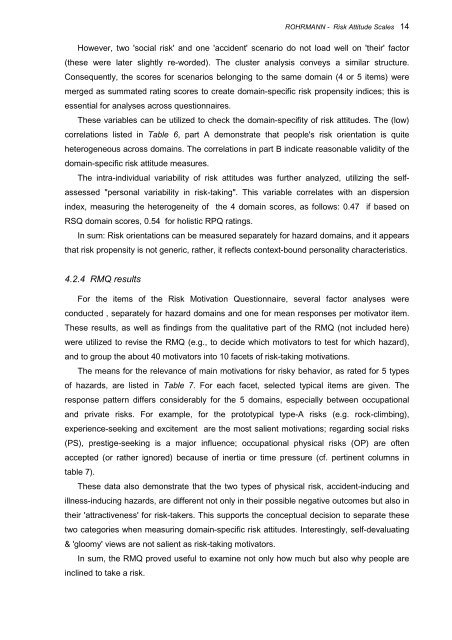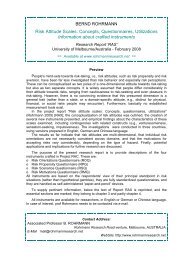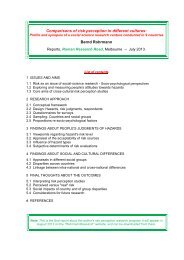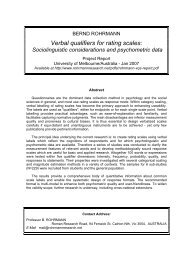Risk Attitude Scales: Concepts, Questionnaires, Utilizations
Risk Attitude Scales: Concepts, Questionnaires, Utilizations
Risk Attitude Scales: Concepts, Questionnaires, Utilizations
Create successful ePaper yourself
Turn your PDF publications into a flip-book with our unique Google optimized e-Paper software.
ROHRMANN - <strong>Risk</strong> <strong>Attitude</strong> <strong>Scales</strong> 14<br />
However, two 'social risk' and one 'accident' scenario do not load well on 'their' factor<br />
(these were later slightly re-worded). The cluster analysis conveys a similar structure.<br />
Consequently, the scores for scenarios belonging to the same domain (4 or 5 items) were<br />
merged as summated rating scores to create domain-specific risk propensity indices; this is<br />
essential for analyses across questionnaires.<br />
These variables can be utilized to check the domain-specifity of risk attitudes. The (low)<br />
correlations listed in Table 6, part A demonstrate that people's risk orientation is quite<br />
heterogeneous across domains. The correlations in part B indicate reasonable validity of the<br />
domain-specific risk attitude measures.<br />
The intra-individual variability of risk attitudes was further analyzed, utilizing the self-<br />
assessed "personal variability in risk-taking". This variable correlates with an dispersion<br />
index, measuring the heterogeneity of the 4 domain scores, as follows: 0.47 if based on<br />
RSQ domain scores, 0.54 for holistic RPQ ratings.<br />
In sum: <strong>Risk</strong> orientations can be measured separately for hazard domains, and it appears<br />
that risk propensity is not generic, rather, it reflects context-bound personality characteristics.<br />
4.2.4 RMQ results<br />
For the items of the <strong>Risk</strong> Motivation Questionnaire, several factor analyses were<br />
conducted , separately for hazard domains and one for mean responses per motivator item.<br />
These results, as well as findings from the qualitative part of the RMQ (not included here)<br />
were utilized to revise the RMQ (e.g., to decide which motivators to test for which hazard),<br />
and to group the about 40 motivators into 10 facets of risk-taking motivations.<br />
The means for the relevance of main motivations for risky behavior, as rated for 5 types<br />
of hazards, are listed in Table 7. For each facet, selected typical items are given. The<br />
response pattern differs considerably for the 5 domains, especially between occupational<br />
and private risks. For example, for the prototypical type-A risks (e.g. rock-climbing),<br />
experience-seeking and excitement are the most salient motivations; regarding social risks<br />
(PS), prestige-seeking is a major influence; occupational physical risks (OP) are often<br />
accepted (or rather ignored) because of inertia or time pressure (cf. pertinent columns in<br />
table 7).<br />
These data also demonstrate that the two types of physical risk, accident-inducing and<br />
illness-inducing hazards, are different not only in their possible negative outcomes but also in<br />
their 'attractiveness' for risk-takers. This supports the conceptual decision to separate these<br />
two categories when measuring domain-specific risk attitudes. Interestingly, self-devaluating<br />
& 'gloomy' views are not salient as risk-taking motivators.<br />
In sum, the RMQ proved useful to examine not only how much but also why people are<br />
inclined to take a risk.





